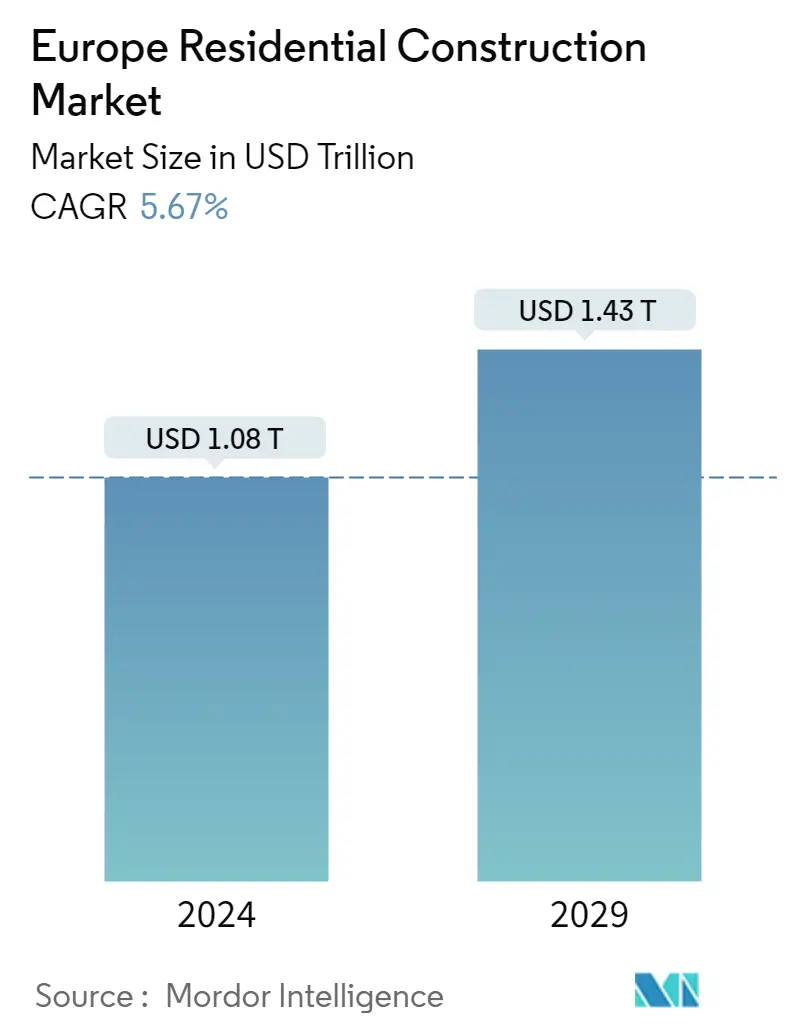Market Size of Europe Residential Construction Industry

| Study Period | 2020 - 2029 |
| Base Year For Estimation | 2023 |
| Market Size (2024) | USD 1.08 Trillion |
| Market Size (2029) | USD 1.43 Trillion |
| CAGR (2024 - 2029) | 5.67 % |
| Market Concentration | Low |
Major Players
*Disclaimer: Major Players sorted in no particular order |
Need a report that reflects how COVID-19 has impacted this market and its growth?
Europe Residential Construction Market Analysis
The Europe Residential Construction Market size is estimated at USD 1.08 trillion in 2024, and is expected to reach USD 1.43 trillion by 2029, growing at a CAGR of 5.67% during the forecast period (2024-2029).
- During the COVID-19 pandemic, the European residential construction market saw an unprecedented boom. As the initial restrictions eased, the strong demand for housing led to house prices soaring. In Estonia, Czechia, Hungary, and Lithuania, house prices rose by over 20% between the second quarter of 2021 and the second quarter of 2022. In the Netherlands, Slovakia, and Latvia, price growth was between 15 and 20%. Mortgage rates in Europe had hit a record low during the coronavirus crisis as nations dealt with the pandemic's economic impacts. The cost of borrowing money for a home increased due to central banks raising interest rates in response to skyrocketing inflation. In Poland, the typical mortgage interest rate rose from 2.9% in the previous year to over 8% in the second quarter of 2022.
- The trend toward sustainable construction is expanding in Europe due to growing concerns over accelerating climate change and greater knowledge of how the construction industry contributes to greenhouse gas emissions. Furthermore, top construction firms and regional governments are using sustainable and bio-based building materials to improve the energy efficiency of construction activities. For instance, the French government announced in February 2020 that it would introduce a sustainability law requiring new public buildings to use at least 50% wood or other bio-based materials. In Germany, the volume of investments in green buildings reached EUR 12 billion (USD 13.17 billion) in 2021. It is expected to foster the demand for green buildings, which is projected to fuel the growth of the residential construction market in Europe.
- Building information modeling (BIM) and other cutting-edge technologies are being used more frequently in the European residential construction market to increase the effectiveness of construction operations. Integrating augmented and virtual reality with building information modeling will make it easier to manage and carry out construction projects and improve worker safety. It is anticipated to impact the market's growth throughout the forecast period positively. However, the need for more building materials raises the overall construction cost, which is projected to hamper the residential construction market growth during the forecast period.
Europe Residential Construction Industry Segmentation
Residential construction is a process that involves the expansion, renovation, or construction of a new home or spaces intended to be occupied for residential purposes. In the residential construction market, buildings are constructed and sold to customers.
Europe's Residential Construction Market is segmented by property type (single-family and multi-family), construction type (new construction and renovation), and country (Germany, United Kingdom, France, Italy, and the rest of Europe).
The Europe Residential Construction Market report offers the market sizes and forecasts in value (USD) for all the above segments and the impact of COVID-19 on the market.
| By Property Type | |
| Single-family | |
| Multi-family |
| By Construction Type | |
| New Construction | |
| Renovation |
| By Country | |
| Germany | |
| United Kingdom | |
| France | |
| Italy | |
| Rest of Europe |
Europe Residential Construction Market Size Summary
The Europe Residential Construction Market is experiencing significant growth, driven by factors such as a surge in housing demand post-COVID-19, a trend towards sustainable construction, and the rising use of cutting-edge technologies like building information modeling (BIM). The market saw a boom during the pandemic, with house prices soaring due to strong demand for housing. Furthermore, the market is also being shaped by the increasing focus on sustainable construction, driven by concerns over climate change and the construction industry's contribution to greenhouse gas emissions. The use of sustainable and bio-based building materials to improve energy efficiency is also on the rise. In addition, the market is seeing an increase in investments in multifamily residential construction, driven by rising house prices, urbanization, and changing consumer preferences. Germany, in particular, is witnessing significant growth in the market, fueled by a large number of immigrants demanding new homes and government initiatives to provide affordable housing. The market landscape is fragmented with a mix of global and local players, with key players expanding their businesses through mergers, acquisitions, strategic partnerships, etc., to meet the increasing demand from end-users.
Explore MoreEurope Residential Construction Market Size - Table of Contents
-
1. MARKET INSIGHTS
-
1.1 Current Market Scenario
-
1.2 Technological Innovations in the Residential Construction Sector
-
1.3 Industry Value Chain/Supply Chain Analysis
-
1.4 Government Initiatives and Regulatory Aspects in the Europe Residential Construction Market
-
1.5 Insights into Affordable Housing Support Provided by Government and Public-private Partnerships
-
1.6 Insights into Services allied to Construction (Design and Engineering, Fit-out Services, Facility management, etc.)
-
1.7 Insights into Costs Related to Construction and Building Materials
-
1.8 Impact of COVID-19 on the Market
-
-
2. MARKET SEGMENTATION
-
2.1 By Property Type
-
2.1.1 Single-family
-
2.1.2 Multi-family
-
-
2.2 By Construction Type
-
2.2.1 New Construction
-
2.2.2 Renovation
-
-
2.3 By Country
-
2.3.1 Germany
-
2.3.2 United Kingdom
-
2.3.3 France
-
2.3.4 Italy
-
2.3.5 Rest of Europe
-
-
Europe Residential Construction Market Size FAQs
How big is the Europe Residential Construction Market?
The Europe Residential Construction Market size is expected to reach USD 1.08 trillion in 2024 and grow at a CAGR of 5.67% to reach USD 1.43 trillion by 2029.
What is the current Europe Residential Construction Market size?
In 2024, the Europe Residential Construction Market size is expected to reach USD 1.08 trillion.
